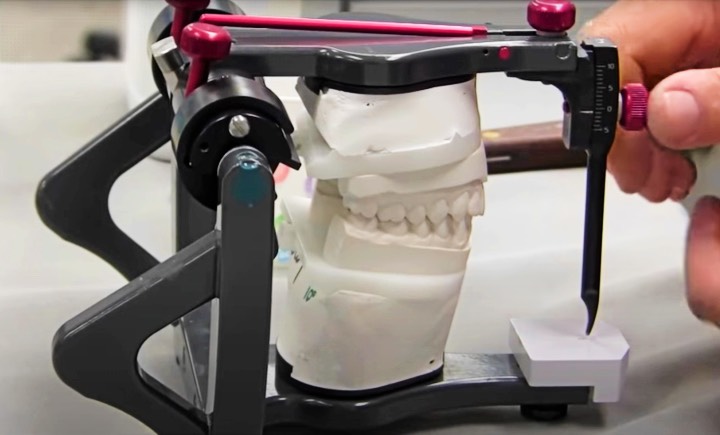
Frequent headaches, jaw tension, teeth clenching or grinding can be caused by temporomandibular joint (TMJ) dysfunction. Bite calibration may resolve this.
Why does the alignment of your teeth and jaw matter so much? Having an aligned bite, compared to a misaligned bite, is vitally important. It’s just that typically people are not familiar with the symptoms or ramifications of bite and jaw problems.
Your jaw joint is normally seated against the base of your skull. This is the correct position to be comfortable and avoid muscle tension. When you bite together your teeth should mesh together in this position. It will only do this if the jaw is in the right place.
Most people’s teeth do mesh together really well but it’s not necessarily in the same place that the joint is in when it’s seated. That’s when there is a discrepancy.
There are a number of reasons why your teeth and jaws don’t come together correctly. These include things such as developmental defects, orthodontics, oral surgery, physical trauma, grinding and clenching of teeth, or even dental work that you may have had done in the past.

TMJ dysfunction
Frequent headaches, jaw/muscle tension, teeth clenching or grinding can be caused by temporomandibular joint (TMJ) issues or dysfunction. Bite analysis and equilibration can help resolve this.
Having an aligned bite can be vitally important. Typically, people aren’t familiar with the symptoms or ramifications of bite and TMJ problems.
Your TMJ has a “happy place” that it correctly fits into anatomically. Ideally, your teeth also fit together when your TMJ is in this seated position. This Is your “occlusion”.
Some people have ‘interferences’ on their teeth when they bite together that cause a shunt or slide when they bite together. So when they bite or chew, the TMJ isn’t working in its seated position.
This can cause pain, cracks and mobility in the teeth, with tension and pain in the jaw muscles and TMJ itself.
The chewing muscles can become very painful and cause facial aches and headaches.
Through analysing your bite with accurate models of your teeth mounted on a dental Articulator we can adjust the shape of the teeth, removing the interferences so that your bite is correct and the occlusion of your teeth and jaws will be much more comfortable.
The risks of undetected and untreated issues
A misaligned or “bad bite” (also known as occlusal disease or unbalanced occlusion) can mean you already have dental issues that you may not be aware of. Or that dental issues could well develop in the future.
The correct alignment of your teeth and jaw (stable occlusion) can prevent or resolve damage to your teeth, jaw muscles, supporting bone and jaw, and temporomandibular joints (TMJ).
If your bite isn’t working properly, or is unbalanced, it can cause multiple problems…
Headaches & joint pain
You might be surprised to learn that a misaligned bite can be the cause of frequent headaches. Tired cheek muscles are another possible indication. Very often sufferers aren’t aware these issues may have something to do with how their teeth meet and how their jaw works (TMJ dysfunction).
Through equilibration, your jaw can be correctly aligned and the pressure on the jaw joints, neck, and head released. Goodbye headaches!
Worn teeth
You may have noticed that as you get older your teeth wear? They get shorter, the end edge of the tooth gets flattened, and the teeth look smaller.
This is a very complex issue and varies enormously between individuals.
People who grind their teeth generate a lot of force and can create erosion of the biting surfaces. This can wear through the enamel and into the softer underlying dentine. Then the wear accelerates because dentine wears 5-7 times faster than enamel.
If your mouth is acidic, your teeth will wear faster because the enamel is softened by the acidity. So, if you drink carbonated drinks, acidic juices and foods, or have gastric reflux, your wear rate will be much faster.
The way your bite works also affects how much you grind your teeth.
Ideally when your jaw joint is fully seated, your teeth all meet evenly with no shunts or slides to get into position. Then when you grind sideways, or forwards, only your front teeth touch during the sideways and forwards movements.
This is called your “occlusion”.
Graham has completed a comprehensive course on “occlusion” with the Dawson Academy in the US.
If you have issues with teeth grinding, wear or muscle tenderness, we can analyse your occlusion and help resolve these problems.
We take an accurate record of your teeth and your ideal jaw joint position and work out whether your occlusion needs equilibration.
Teeth clenching & grinding
Teeth clenching, or grinding while sleeping (bruxism), is quite common when you have an uneven bite. The clenching and grinding action can cause headaches, sleeping issues, and worn, cracked or broken teeth.
If you bite together and then grind your teeth side to side and forwards and backwards, ideally only your front teeth will touch and ‘guide’ these movements. If only the front teeth touch during these movements, there is a neuromuscular feedback loop that then stops you from heavily loading the teeth.
If you can still bite your back teeth together when you grind side to side or forwards and backwards, chances are you’ll have no ‘anterior guidance’ and you’ll be able to heavily grind your teeth. This can cause excessive wear, pain cracking and TMJ dysfunction and muscle problems.
Muscle tension
When your bite is properly aligned your jaw joint is seated against the base of your skull. This is the correct position for you to be comfortable and avoid muscle tension and other dental issues.
However, what commonly happens to disrupt things is that you’ll bite together, hit a tooth, and then unconsciously shunt and slide your teeth to get them meshing together properly. It’s this unconscious action that disrupts the position of your jaw joint against the fossa of your skull. The resulting muscle tension can cause a lot of problems for some people.
The answer is equilibration so that your bite is correctly guided to work beautifully and eliminate muscle pain.
How is a “bad bite” corrected?
A model of your mouth is created before treatment and then placed on a calibrated instrument called an articulator. The articulator is used to simulate your jaw movement and highlight any issues in the way your teeth come together and the way your jaw closes. From the diagnosis, adjustments can be made to ensure the forces are balanced and your bite works optimally.
Comprehensive training in USA
Graham has a particular interest in bite equilibration and carried out his training at the respected Dawson Institute in Florida, USA. He completed a 7-module programme over the course of 18 months and is now well skilled in bite and jaw correction via equilibration.
What if you don’t have symptoms?
Some clients don’t have neuromuscular or muscle joint symptoms but do have a lot of wear on their teeth. Often they are unaware of the degree of wear and don’t realise how much damage is being done.
They may have very worn, flat teeth and not understand that if there is wear into the dentine, it will be wearing at 5-7 times the rate of enamel. This is worth taking seriously.
With people living longer and wanting to keep their teeth, an exponential increase in the speed of dental wear is a problem. Previously it was expected you would lose your teeth around age 50 or 60.
Now we know that if you want to keep your teeth into your later years, it’s very important that your bite and jaw are working correctly. Through equilibration it’s less likely you’ll have painful dental issues in the future, and you’ll greatly improve the chances of retaining your teeth for your lifetime.
Curious about how balanced your bite is?
Graham has a strong interest in this area and would love to help.
Talk to us about TMJ dysfunction and bite calibration…Phone 360-2475 » (click to call) |
